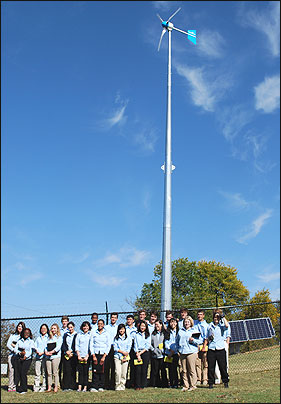Students from the School for Science and Math at Vanderbilt trekked about three miles from campus to the School of Engineering’s wind-solar alternative energy site to see a wind turbine in action atop Love Circle hill in Nashville.

“The turbine was in full swing, catching strong late October winds,” said Amrutur Anilkumar, professor of the practice of mechanical engineering and director of the showcase wind and solar facilities. The site was created in collaboration with the school and Metro Water Services.
Three faculty members and 24 students got a complete run down of the turbine siting, energy estimation, facility design, installation, operation and other engineering issues tackled in the context of setting up the site. “The visit complements their lesson plans on renewable energy and the students clearly had spent time reviewing the information on the VU/MWS Renewable Energy Showcase website,” Anilkumar said. www.vanderbilt.edu/lc
Anilkumar said the small but efficient and quiet 3kW (kilowatt) turbine was chosen based on the proximity of homes on Love Circle, neighborhood aesthetics and noise. Love Circle hill is one of the highest points in Nashville and the wind speeds at the hill are high enough for wind power generation, especially during the months November through April. The solar panels will be most effective in the May to September months.
The main purpose of the project is to examine the feasibility of alternative energy production through solar and wind facilities, and the expectation is that about 30kWh (kilowatt hours) of power will be generated on a daily basis. 30kWh is the average daily consumption of electrical power per household across the United States, according to the U.S. Energy Information Administration.
On Aug. 1 the Tennessee Valley Authority switched on the energy facilities. “During the first week the solar panels generated 118 kWh and the wind turbine 16 kWh of green energy,” Anilkumar said.
“The students had tens of questions and the hands never came down,” he said. “It is amazing that renewable and sustainable energy is so much on top of their minds, and I am glad the winds were strong during their visit.” That day the wind turbine produced 10 kWh and the solar panels produced 19 kWh of energy.
Metro public school students in the School for Science and Math at Vanderbilt attend classes on campus one day per week. It is a free, four-year program limited to 25 students per grade. For three consecutive summers, students complete team research projects and independent internships. As rising seniors, they are placed in research laboratories to work on independent projects intended for national science competitions.